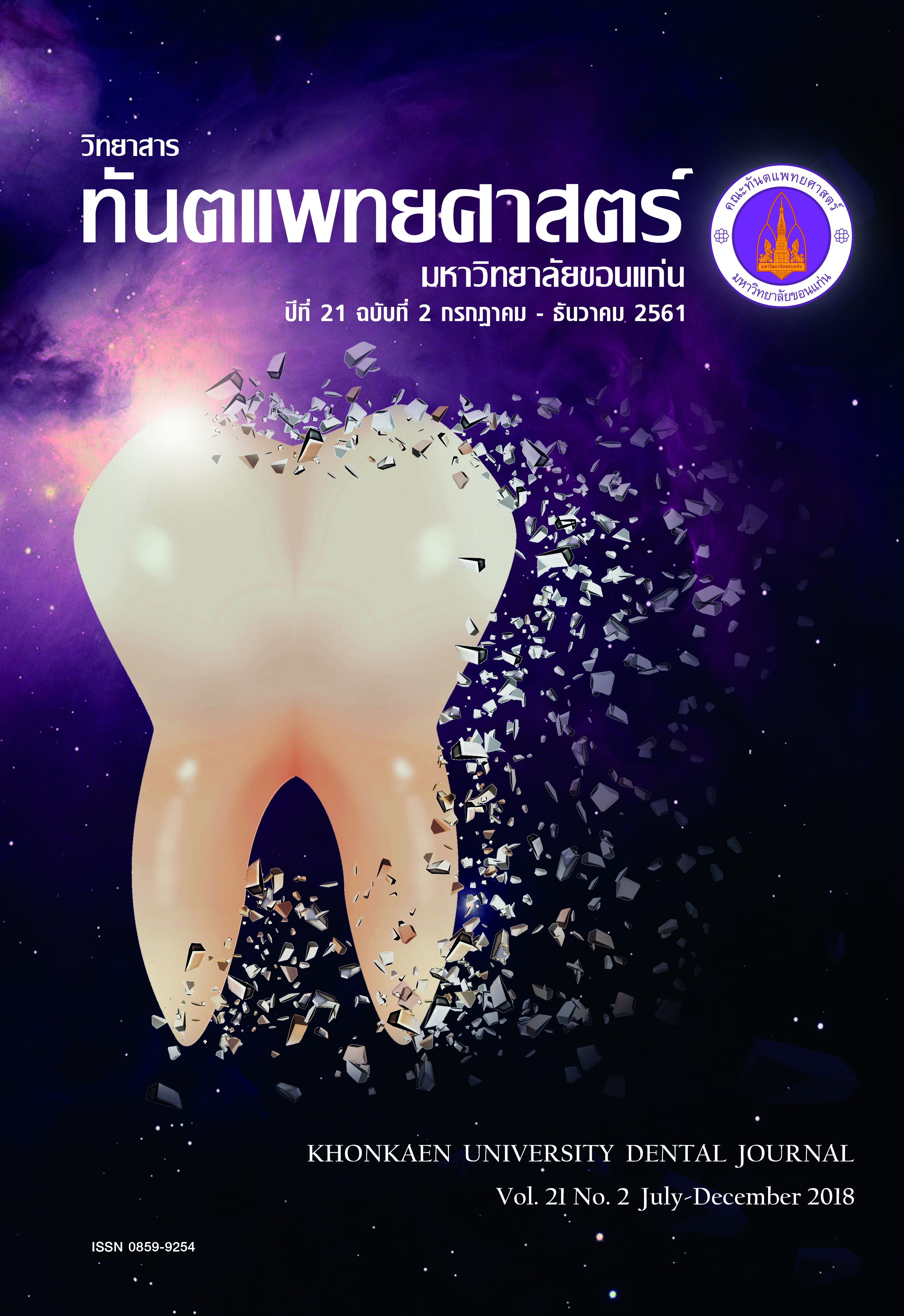Effect of Surface Treatments on Micro-Shear Bond Strength of Componeer Brilliant and Resin Composite
Main Article Content
Abstract
The purpose of this study was to compare micro-shear bond strength of resin composite to Componeer Brilliant treated with different surface treatment methods and with or without silane coupling agent. Onehundred-eighty componeer Brilliant were divided into 12 groups of 15 specimens. Each group was subject to surface treatments as followed; no surface treatment (control), phosphoric acid, diamond bur, sandblast, diamond bur-phosphoric acid, sandblast-phosphoric acid. Every treated surface was further treated with or without silane coupling agent. Adhesive was applied on all specimens and bonded to resin composite. After polymerization, the specimens were thermocycledfor 500 cycles and subjected to micro-shear bond strength test with the Universal Testing Machine. Fracture mode of all specimen was examined under a stereomicroscope with 30x magnification. Morphological features of treated Componeer Brilliant surfaces were analyzed under SEM. Results showed that Componeer Brilliant treated with sandblast-phosphoric acid had the maximum bond strength (19.91±2.52 MPa), demonstrating significant difference when compared with control group (p-value <0.001). Control group showed the minimum bond strength (14.82±1.59 MPa). The bond strength in sandblast group, diamond bur-phosphoric acid group, and sandblast-phosphoric acid group were increased significantly (p-value< 0.05) when further treated with silane coupling agent. Most commonly found fracture mode was adhesive failure as determined by fracture analysis. SEM evaluation showed irregularities on surfaces after treatment with diamond bur and sandblast.
Article Details
บทความ ข้อมูล เนื้อหา รูปภาพ ฯลฯ ที่ได้รับการลงตีพิมพ์ในวิทยาสารทันตแพทยศาสตร์ มหาวิทยาลัยขอนแก่นถือเป็นลิขสิทธิ์เฉพาะของคณะทันตแพทยศาสตร์ มหาวิทยาลัยขอนแก่น หากบุคคลหรือหน่วยงานใดต้องการนำทั้งหมดหรือส่วนหนึ่งส่วนใดไปเผยแพร่ต่อหรือเพื่อกระทำการใด ๆ จะต้องได้รับอนุญาตเป็นลายลักษณ์อักษร จากคณะทันตแพทยศาสตร์ มหาวิทยาลัยขอนแก่นก่อนเท่านั้น
References
2. Dietschi D, Devigus A. Prefabricated composite veneers:historical perspectives, indications and clinical application. Eur J of Esthet Dent 2011;6(2):178-87.
3. Migliau G, Besharat LK, Sofan AA, Sofan EA, Romeo U. Endo-restorative treatment of a severly discolored upper incisor: resolution of the “aesthetic” problem through Componeer veneering System. Ann Stomatol 2015;6(3-4):113-8.
4. Wakiaga J, Brunton P, Silikas N, Glenny AM. Direct versus indirect veneer restorations for intrinsic dental stains. Cochrane Database Syst Rev 2004(1):CD004347.
5. Mangani F, Cerutti A, Putignano A, Bollero R, Madini L. Clinical approach to anterior adhesive restorations using resin composite veneers. Eur J of Esthet Dent 2007;2(2):188-209.
6. Cetin AR, Unlu N, Cobanoglu N. A five-year clinical evaluation of direct nanofilled and indirect composite resin restorations in posterior teeth. Oper Dent 2013;38(2):E1-11.
7. Touati B. The evolution of aesthetic restorative materials for inlays and onlays: a review. Pract Periodontics Aesthet Dent: PPAD 1996;8(7):657-66.
8. Hoffding J. Mastique laminate veneers: results after 4 and 10 years of service. Acta Odontol Scand 1995;53(5):283-6
9. Perdigao J, Sezinando A, Munoz MA, Luque-Martinez IV, Loguercio AD. Prefabricated veneers - bond strengths and ultramorphological analyses. J Adhes Dent 2014;16(2):137-46.
10. O’Brian W, Chicago. Dental Materials and their Selection 2002:75-90.
11. Najafi-Abrandabadi A, Najafi-Abrandabadi S, Ghasemi A, Kotick PG. Microshear bond strength of composite resins to enamel and porcelain substrates utilizing unfilled versus filled resins. Dent Res J 2014;11(6):636-44.
12. Shahdad SA, Kennedy JG. Bond strength of repaired anterior composite resins: an in vitro study. J Dent 1998;26(8):685-94.
13. Brosh T, Pilo R, Bichacho N, Blutstein R. Effect of combinations of surface treatments and bonding agents on the bond strength of repaired composites. Journal Prosthet Dent 1997;77(2):122-6.
14. Furuse AY, da Cunha LF, Benetti AR, Mondelli J. Bond strength of resin-resin interfaces contaminated with saliva and submitted to different surface treatments. J Appl Oral Sci: revista FOB 2007;15(6):501-5.
15. Foong J, Lee K, Nguyen C, Tang G, Austin D, Ch’ng C, et al. Comparison of microshear bond strengths of four selfetching bonding systems to enamel using two test methods. Aust Dent J 2006;51(3):252-7.
16. Adebayo OA, Burrow MF, Tyas MJ. Bond strength test: role of operator skill. Aust Dent J 2008;53(2):145-50.
17. Baur V, Ilie N. Repair of dental resin-based composites. Clin Oral Investig 2013;17(2):601-8.
18. Jafarzadeh Kashi TS, Erfan M, Rakhshan V, Aghabaigi N, Tabatabaei FS. An in vitro assessment of the effects of three surface treatments on repair bond strength of aged composites. Oper Dent 2011;36(6):608-17.
19. Papacchini F, Dall’Oca S, Chieffi N, Goracci C, Sadek FT, Suh BI, et al. Composite-to-composite microtensile bond strength in the repair of a microfilled hybrid resin: effect of surface treatment and oxygen inhibition. J Adhes Dent 2007;9(1):25-31.
20. Ahmadizenouz G, Esmaeili B, Taghvaei A, Jamali Z, Jafari T, Amiri Daneshvar F, et al. Effect of different surface treatments on the shear bond strength of nanofilled composite repairs. J Dent Res Dent Clin Dent Prospects 2016;10(1):9-16.
21. Loomans BAC, Cardoso MV, Roeters FJM, Opdam NJM, De Munck J, Huysmans MCDNJM, et al. Is there one optimal repair technique for all composites? Dent Mater 2011;27(7):701-9.
22. Hasani Tabatabaei M, Alizade Y, Taalim S. Effect of various surface treatment on repair strength of composite resin. J Dent TUMS 2004;1:5-11.
23. Visuttiwattanakorn P, Suputtamongkol K, Angkoonsit D, Kaewthong S, Charoonanan P. Microtensile bond strength of repaired indirect resin composite. J Adv Prosthodent 2017;9(1):38-44.
24. Maneenut C, Sakoolnamarka R, Tyas MJ. The repair potential of resin composite materials. Dent Mater 2011;27(2):e20-7.
25. Rinastiti M, Ozcan M, Siswomihardjo W, Busscher HJ. Immediate repair bond strengths of microhybrid, nanohybrid and nanofilled composites after different surface treatments. J Dent 2010;38(1):29-38.
26. Cavalcanti AN, De Lima AF, Peris AR, Mitsui FH, Marchi GM. Effect of surface treatments and bonding agents on the bond strength of repaired composites. J Esthet Restor Dent 2007;19(2):90-8.


